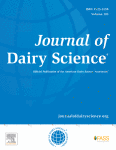Ver ítem
- xmlui.general.dspace_homeCentros e Institutos de InvestigaciónCICVyA. Centro de Investigación en Ciencias Veterinarias y AgronómicasInstituto de VirologíaArtículos científicosxmlui.ArtifactBrowser.ItemViewer.trail
- Inicio
- Centros e Institutos de Investigación
- CICVyA. Centro de Investigación en Ciencias Veterinarias y Agronómicas
- Instituto de Virología
- Artículos científicos
- Ver ítem
Efficacy of the spray-drying treatment to inactivate the bovine leukemia virus in bovine colostrum
Resumen
Previous studies have shown the presence of bovine leukemia virus (BLV) in colostrum and milk of naturally infected cows. The relationship between virus or provirus and specific antibodies in these secretions is particular to each infected cow and will probably determine whether the consumption of colostrum or milk from these naturally infected dams provides an infective or a protective effect in recipient calves. Our recent findings suggest that this
[ver mas...]
Previous studies have shown the presence of bovine leukemia virus (BLV) in colostrum and milk of naturally infected cows. The relationship between virus or provirus and specific antibodies in these secretions is particular to each infected cow and will probably determine whether the consumption of colostrum or milk from these naturally infected dams provides an infective or a protective effect in recipient calves. Our recent findings suggest that this issue is a key point in BLV transmission in very young calves. Based on this, the aim of the present study was to determine the effect of the spray-drying treatment of colostrum on BLV infectivity. The treatment was done on scale-down conditions, using fresh colostrum from BLV-negative cows spiked with infective BLV. Residual infectivity was tested in susceptible lambs. Lambs inoculated with colostrum spiked with BLV-infected cells or cell-free BLV showed evidence of infection 60 d after inoculation, whereas none of the lambs inoculated with spray-dried colostrum showed evidence of infection 60 d after inoculation. These results provide direct evidence that the experimental spray-drying process used in this study was effective in inactivating infectious BLV in colostrum. These findings suggest that the risk for BLV transmission could be reduced if milk and colostrum were treated by spray-drying prior to consumption in dairy facilities. The effect of spray-drying on the functional properties and stability of the antibodies present in colostrum under long-term storage should be further investigated.
[Cerrar]

Autor
Lomonaco, Marina;
Sowul, Mariana;
Gutierrez, Gerónimo;
Malacari, Darío Amilcar;
Alvarez, Irene;
Porta, Natalia Gabriela;
Zabal, Osvaldo Alfredo;
Trono, Karina Gabriela;
Fuente
Journal of dairy science 103 (7) : 6504-6510. (Julio 2020)
Fecha
2020-07
Editorial
Elsevier
ISSN
1525-3198
Documentos Relacionados
Formato
pdf
Tipo de documento
artículo
Proyectos
(ver más)
INTA/PNSA-1115054/AR./Enfermedades parasitarias, infecciosas y tóxico metabólicas que afectan la productividad de los bóvidos para producción de carne y leche.
Palabras Claves
Derechos de acceso
Restringido
 Excepto donde se diga explicitamente, este item se publica bajo la siguiente descripción: Creative Commons Attribution-NonCommercial-ShareAlike 2.5 Unported (CC BY-NC-SA 2.5)
Excepto donde se diga explicitamente, este item se publica bajo la siguiente descripción: Creative Commons Attribution-NonCommercial-ShareAlike 2.5 Unported (CC BY-NC-SA 2.5)

